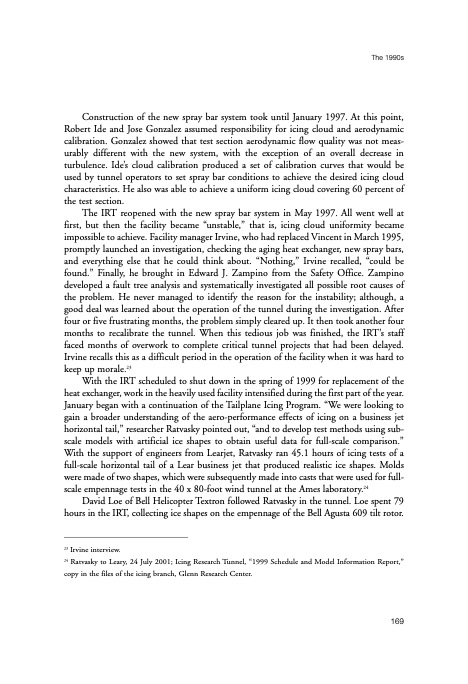
PDF Publication Title:
Text from PDF Page: 180
Construction of the new spray bar system took until January 1997. At this point, Robert Ide and Jose Gonzalez assumed responsibility for icing cloud and aerodynamic calibration. Gonzalez showed that test section aerodynamic flow quality was not meas- urably different with the new system, with the exception of an overall decrease in turbulence. Ide’s cloud calibration produced a set of calibration curves that would be used by tunnel operators to set spray bar conditions to achieve the desired icing cloud characteristics. He also was able to achieve a uniform icing cloud covering 60 percent of the test section. The IRT reopened with the new spray bar system in May 1997. All went well at first, but then the facility became “unstable,” that is, icing cloud uniformity became impossible to achieve. Facility manager Irvine, who had replaced Vincent in March 1995, promptly launched an investigation, checking the aging heat exchanger, new spray bars, and everything else that he could think about. “Nothing,” Irvine recalled, “could be found.” Finally, he brought in Edward J. Zampino from the Safety Office. Zampino developed a fault tree analysis and systematically investigated all possible root causes of the problem. He never managed to identify the reason for the instability; although, a good deal was learned about the operation of the tunnel during the investigation. After four or five frustrating months, the problem simply cleared up. It then took another four months to recalibrate the tunnel. When this tedious job was finished, the IRT’s staff faced months of overwork to complete critical tunnel projects that had been delayed. Irvine recalls this as a difficult period in the operation of the facility when it was hard to keep up morale.23 With the IRT scheduled to shut down in the spring of 1999 for replacement of the heat exchanger, work in the heavily used facility intensified during the first part of the year. January began with a continuation of the Tailplane Icing Program. “We were looking to gain a broader understanding of the aero-performance effects of icing on a business jet horizontal tail,” researcher Ratvasky pointed out, “and to develop test methods using sub- scale models with artificial ice shapes to obtain useful data for full-scale comparison.” With the support of engineers from Learjet, Ratvasky ran 45.1 hours of icing tests of a full-scale horizontal tail of a Lear business jet that produced realistic ice shapes. Molds were made of two shapes, which were subsequently made into casts that were used for full- scale empennage tests in the 40 x 80-foot wind tunnel at the Ames laboratory.24 David Loe of Bell Helicopter Textron followed Ratvasky in the tunnel. Loe spent 79 hours in the IRT, collecting ice shapes on the empennage of the Bell Agusta 609 tilt rotor. The 1990s 23 Irvine interview. 24 Ratvasky to Leary, 24 July 2001; Icing Research Tunnel, “1999 Schedule and Model Information Report,” copy in the files of the icing branch, Glenn Research Center. 169PDF Image | History of NASA Icing Research Tunnel

PDF Search Title:
History of NASA Icing Research TunnelOriginal File Name Searched:
sp4226.pdfDIY PDF Search: Google It | Yahoo | Bing
NFT (Non Fungible Token): Buy our tech, design, development or system NFT and become part of our tech NFT network... More Info
IT XR Project Redstone NFT Available for Sale: NFT for high tech turbine design with one part 3D printed counter-rotating energy turbine. Be part of the future with this NFT. Can be bought and sold but only one design NFT exists. Royalties go to the developer (Infinity) to keep enhancing design and applications... More Info
Infinity Turbine IT XR Project Redstone Design: NFT for sale... NFT for high tech turbine design with one part 3D printed counter-rotating energy turbine. Includes all rights to this turbine design, including license for Fluid Handling Block I and II for the turbine assembly and housing. The NFT includes the blueprints (cad/cam), revenue streams, and all future development of the IT XR Project Redstone... More Info
Infinity Turbine ROT Radial Outflow Turbine 24 Design and Worldwide Rights: NFT for sale... NFT for the ROT 24 energy turbine. Be part of the future with this NFT. This design can be bought and sold but only one design NFT exists. You may manufacture the unit, or get the revenues from its sale from Infinity Turbine. Royalties go to the developer (Infinity) to keep enhancing design and applications... More Info
Infinity Supercritical CO2 10 Liter Extractor Design and Worldwide Rights: The Infinity Supercritical 10L CO2 extractor is for botanical oil extraction, which is rich in terpenes and can produce shelf ready full spectrum oil. With over 5 years of development, this industry leader mature extractor machine has been sold since 2015 and is part of many profitable businesses. The process can also be used for electrowinning, e-waste recycling, and lithium battery recycling, gold mining electronic wastes, precious metals. CO2 can also be used in a reverse fuel cell with nafion to make a gas-to-liquids fuel, such as methanol, ethanol and butanol or ethylene. Supercritical CO2 has also been used for treating nafion to make it more effective catalyst. This NFT is for the purchase of worldwide rights which includes the design. More Info
NFT (Non Fungible Token): Buy our tech, design, development or system NFT and become part of our tech NFT network... More Info
Infinity Turbine Products: Special for this month, any plans are $10,000 for complete Cad/Cam blueprints. License is for one build. Try before you buy a production license. May pay by Bitcoin or other Crypto. Products Page... More Info
| CONTACT TEL: 608-238-6001 Email: greg@infinityturbine.com | RSS | AMP |